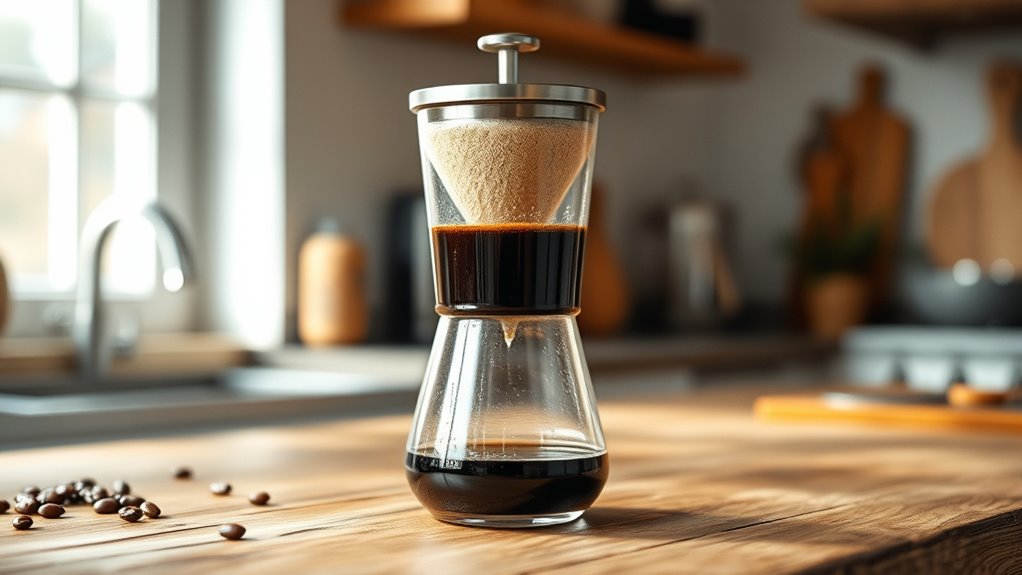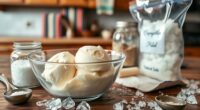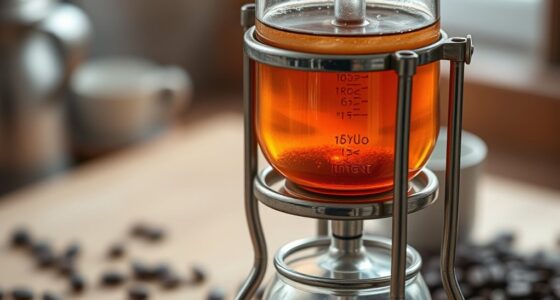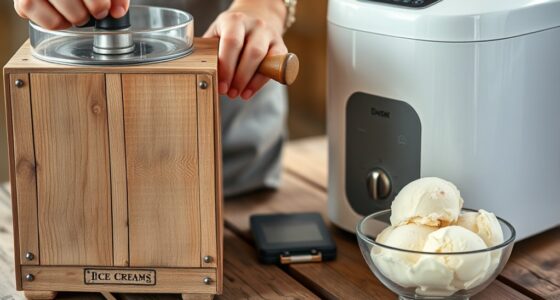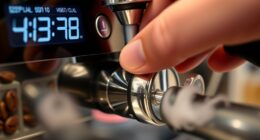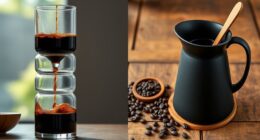To choose the right cold brew coffee maker, consider your budget, space, and how much effort you want to put in. Budget options are simple and affordable, while higher-end models offer advanced features like faster brewing or filtration options. Think about the size of the machine, how much coffee it makes at once, and whether you prefer manual or automated functions. Keep these factors in mind to find the best fit, and you’ll discover more tips for making great cold brew.
Key Takeaways
- Consider capacity needs to select between single-serve, small batch, or large-volume cold brew makers.
- Check for brewing time, as some models produce cold brew in 12–24 hours, others faster with added features.
- Look for durable materials like stainless steel or BPA-free plastics for safety and longevity.
- Decide between manual or automated systems based on convenience, effort, and desired flavor consistency.
- Evaluate maintenance requirements, including filter type, cleaning ease, and parts replacement.
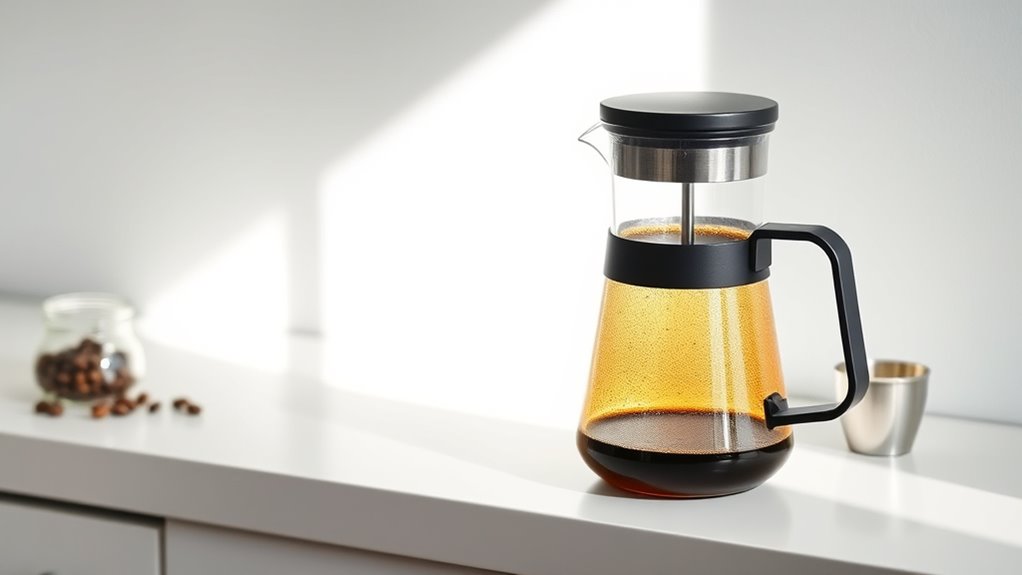
Cold brew coffee makers have become essential tools for coffee enthusiasts seeking smooth, flavorful drinks with minimal effort. When choosing one, you’ll find a wide price range, from budget-friendly manual models under $25 to high-end automated systems costing over $600.
Manual brewers, like the Pegasus, are affordable and straightforward but require more manual effort and attention. These typically cost less than $25 and often include simple features, making them ideal if you’re on a tight budget or prefer hands-on control.
Manual brewers like the Pegasus are budget-friendly, simple, and perfect for hands-on coffee enthusiasts.
On the other hand, automated brewers, such as Spinn, come with advanced functions like centrifugal chambers that produce cold brew in about a minute, but they come with a hefty price tag of $600 or more. These models offer multipurpose functionality, including the ability to infuse nitrogen for a creamy, foamy texture, making them suitable for those seeking convenience and versatility.
Mid-tier options, like the OXO, usually cost between $50 and $100. They strike a good balance, offering useful features such as programmable settings, water distribution systems like the Rainmaker, and dishwasher-safe components that make cleanup easier.
These models are often compact enough to fit most kitchens and refrigerators, with batch sizes ranging from single-serve to 1-gallon containers, accommodating both casual and frequent drinkers.
When considering size and capacity, think about your space and how much cold brew you want to make at once. Countertop units with large footprints, like the Spinn, need over 12 inches of clearance, while manual models fit easily in refrigerators and small spaces.
Brewing features vary considerably. Automated models often include agitation methods like vortex or centrifugal systems, which cut brew times to as little as 10 minutes, while manual systems rely on steeping longer without agitation.
Some high-end models even allow for programmable settings and nitro infusion, enhancing flavor and mouthfeel. Filters come in stainless steel, which are reusable, or paper, which are single-use and disposable.
Water temperature control is standard in electric systems but absent in manual brewers, affecting extraction and flavor profiles. Proper maintenance, such as daily filter cleaning and periodic descaling, is necessary to keep your machine functioning well. Components like gaskets may need replacement after a year.
Performance-wise, automated systems tend to produce more consistent results, with lower acidity and more balanced flavor profiles, especially when grind size and brew time are well-adjusted.
Additionally, advancements in color accuracy and contrast ratio in some models contribute to richer flavor extraction and better overall tasting experience. Reusable filters and focus on sustainability are becoming more common, aligning with consumer preferences. Market trends show an increasing shift toward rapid-brew systems and automated options, especially in specialty coffee shops, while reviews often highlight issues with filter clogging and leaks.
Ultimately, your choice depends on your budget, space, desired features, and how much effort you’re willing to invest in brewing and maintenance.
Frequently Asked Questions
How Long Does Cold Brew Coffee Typically Last in the Refrigerator?
You’re wondering how long cold brew coffee lasts in the fridge. Generally, it stays fresh for 2-7 days if stored in an airtight container.
For the best taste, consume it within 10-14 days, especially if it’s homemade.
Always check for signs of spoilage, like mold, sour smell, or unusual taste.
Keep it refrigerated at 34-40°F and avoid exposure to light to prolong freshness.
Can I Use Regular Coffee Grounds for Cold Brew?
You can use regular coffee grounds for cold brew, but it’s not perfect. Regular grounds are often finer and can lead to over-extraction, resulting in a bitter, gritty brew.
For best results, opt for coarsely ground coffee, which helps you achieve a smooth, balanced flavor.
Pre-ground cold brew coffee is also available, specifically designed to produce ideal flavor and texture, making your cold brew experience much better.
Is a Special Grinder Needed for Cold Brew Coffee Makers?
You don’t need a special grinder for cold brew, but using the right one makes a big difference. A burr grinder is ideal because it produces a consistent, coarse grind that helps with extraction and filtering.
While blade grinders work in a pinch, they can create uneven grounds and heat that harm flavor.
Manual grinders are a good budget choice and give you control, but they require more effort.
What Is the Ideal Coffee-To-Water Ratio for Cold Brew?
Did you know cold brew coffee is typically three to four times stronger than regular coffee?
For your ideal brew, use a ratio of 1:4 to 1:8 of coffee to water for a concentrate, or 1:12 to 1:15 for a ready-to-drink version.
Adjust based on your taste and how you plan to serve it.
Experimenting helps you find the perfect strength that matches your preference.
Are There Any Safety Tips for Cleaning Cold Brew Coffee Makers?
When cleaning your cold brew coffee maker, follow safety tips to keep it in top shape. Use mild soap and warm water, avoiding harsh chemicals that can damage parts.
Rinse thoroughly to prevent cross-contamination, and dry all components with a soft towel to avoid moisture buildup.
Regularly sanitize with food-safe cleaners, and never use a dishwasher unless specified.
These steps guarantee safe, effective cleaning and maintain your equipment’s longevity.
Conclusion
Choosing the right cold brew coffee maker is like finding your perfect brew buddy—one that suits your taste and lifestyle. With so many options out there, don’t settle for less; instead, pick the one that makes your mornings smoother and your coffee richer. Remember, the right machine isn’t just a gadget—it’s your ticket to endless, delicious adventures in every sip. So, why wait? Let your perfect cold brew journey begin today.
